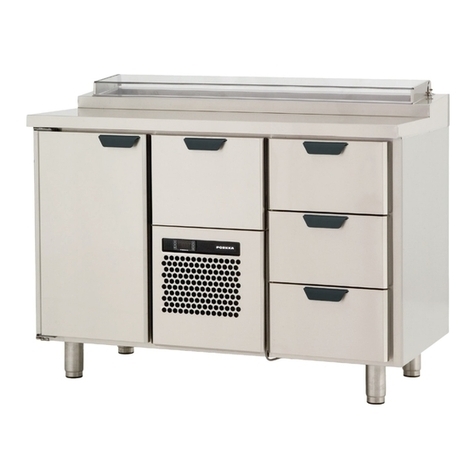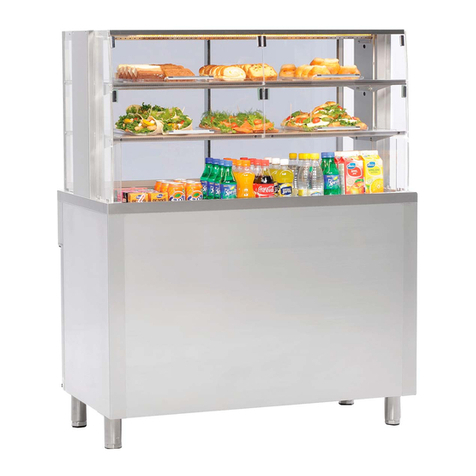2
THESE INSTRUCTIONS ARE FOR BC AND BC/BF BLAST CHILLERS/
BLAST FREEZER. IT IS VERY IMPORTANT TO READ THESE
INSTALLATION AND OPERATING INSTRUCTIONS CAREFULLY
BEFORE YOU START USING THE EQUIPMENT FOR THE FIRST TIME.
ALSO, PLEASE KEEP THESE INSTRUCTIONS IN A SAFE PLACE FOR
FUTURE REFERENCE OR USE BY ANOTHER OPERATOR.
BY FOLLOWING THESE INSTRUCTIONS YOU CAN IMPROVE THE
PRODUCT’S PERFORMANCE AND YOUR PROCESS.
PLEASE NOTE! IT IS IMPORTANT TO HAVE YOUR EQUIPMENT
REGULARLY MAINTAINED BY A PROFESSIONAL ENGINEER.
Check the product as soon as you receive it. If you notice
that it has suffered from damages during transportation, you
must indicate this in the delivery documents and tell about
the matter to the carrier off the retailer.The manufacturer’s
guarantee does not cover damages caused by transportation
INSTALLATION AND INTRODUCTION
The BC/C, BF/F- and BC/BF-cabinets are delivered either
plug-in or as central plant connection ready. The installation
and adjustment should always be done by a qualified
refrigeration engineer. Clean the cabinet with a mild
cleaning agent and wipe dry. Leave the door open for a
while.
POWER SUPPLY
The main lead is earthed. Before connecting the cabinet
to the electricity supply make sure that the socket is
protected with a fuse of 16 A delayed. The voltage must be
240V/50Hz/1-phase. The remote unit requires a separate
power supply. There is no electrical connection between the
cabinet and the refrigeration unit.
REQUIREMENTS OF THE SEPARATE MACHINERY
The power demand of the evaporator and blast chiller has
been described in the manufacturer’s technical information.
The range of use of the refrigerating compressor has to
be suitable for the entire operating range of the blast
refrigeration process of the blast chiller / blast freezer.
Also, the refrigeration system has to follow the alternating
evaporation temperatures of the blast chilling process so
that the requirements of the blast refrigeration phases are fi
lled.
DISHES, AMOUNT OF FOOD
All BC- and BC/BF-cabinet models are designed to accept
GN 1/1-dishes.
THE MAXIMUM CHILLING AMOUNTS
The refrigerating capacity is informed according to the
English DHSS instructions. The maximum chilling amounts
are defined and tested with a 50 mm test package, being:
BLAST CHILLING AND BLAST FREEZING CAPACITIES
BC 960 +70...+3°C 90 min 60 kg
BC 990 +70...+3°C 90 min 90 kg
BC 24-100 +70...+3°C 90 min 100 kg
BC 48-200 +70...+3°C 90 min 2x100 kg
BF 960 0°C...-18°C 2,5 h 35 kg
BF 990 0°C...-18°C 2,5 h 50 kg
BF 960 0°C...-18°C 6 h 60 kg
BF 990 0°C...-18°C 6 h 90 kg
BF 24-100 0°C...-18°C 2,5 h 55 kg
BF 48-200 0°C...-18°C 2,5 h 2x55 kg
BF 24-100 0°C...-18°C 10 h 100 kg
BF 48-200 0°C...-18°C 10 h 2x100 kg
Do not add further warm products once the process has
been started.
Contents
General information ............................................2–4
1 Blast chilling and blast freeing.................................5
2 Capacity of blast chilling and
blast freezing equipment.........................................5
3 General features of blast chilling / blast freezing
equipment ..............................................................6
4 Fish freezing process ............................................... 6
5 Default values of the quick pre-set programs of the
equipment .............................................................7
6 Personalised programs – programming basis............8
7 First time use .......................................................... 9
8 Main menu. ..........................................................10
8.1 Main menu buttons.........................................10
9 Quick programs.....................................................11
9.1 Use of quick programs ..........................................11
10 Personalised programs – use .................................12
10.1 Personalised programs – programming.................. 13
11 Menu....................................................................14
12 Saved HACCP data................................................15
13 Alarms .................................................................15
INVENTUS BLAST CABINETS






























